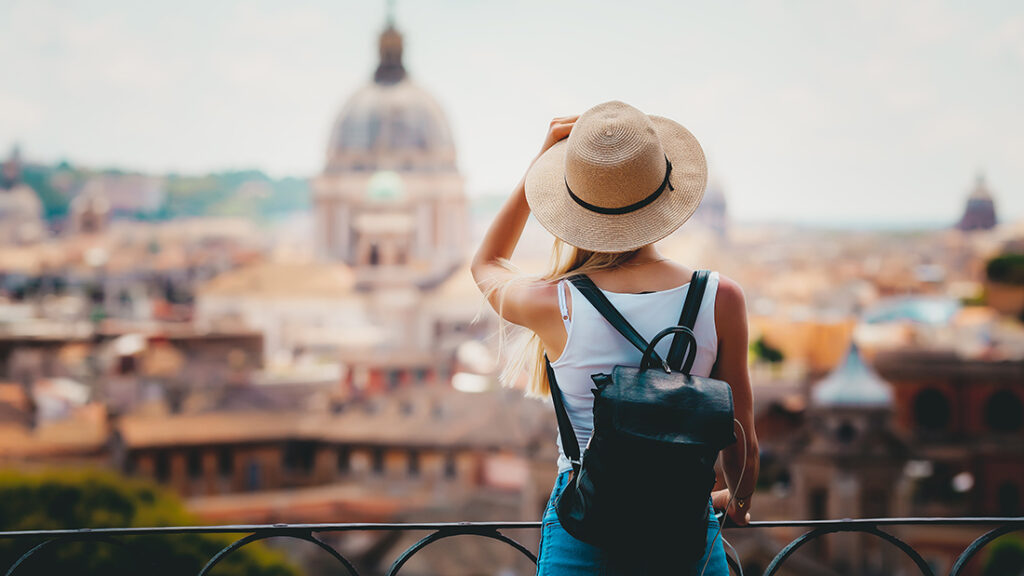The desire to travel is a very real thing that we can see all around us—from our close friends’ Instagram stories to content creators’ travel vlogs that highlight every step of the traveling process, including packing, hopping on the plane and taking in the sights.
With international tourism expected to climb back up to pre-pandemic levels in 2024, it’s unlikely that interest in travel is going to slow down anytime soon. The way we approach travel tends to be fast-paced, with an emphasis on doing as much as you can and seeing as many places as possible. But this is starting to change bit by bit, as interest in slow travel grows.
What is slow travel?
When you first hear the term “slow travel,” you might immediately think about physically slow travel, i.e., traveling by train as opposed to plane or walking to a destination instead of taking a car. While that can be one aspect of slow travel, the concept itself focuses on individuals having a more fulfilling travel experience in a location. Slow travel prioritizes visiting a place—near or far—and taking the time to soak in the local community, food and experiences there.
In a study conducted by Razorfish and VICE Media Group that surveyed “thrifty” travelers, 79% of respondents expressed that traveling isn’t about visiting a new location; it’s about their personal growth during their trip. This idea that traveling isn’t just destination-oriented is a primary part of slow travel, which encourages you to slow down and seek out connections through culture, people, cuisine or other areas of interest. Slow travel is catching on fairly quickly, allowing people to embrace a new mindset about how they travel.
Principles of slow travel
Slow travel is going to look a little different for everyone, but here are some basic principles that can help shift the way you approach travel.
- Stay longer in a location. Slow travel is the opposite of speed running through a city you’ve been waiting to see your whole life. Instead of opting for a day trip, give yourself a few days to thoroughly explore the places you visit.
- Transportation can play a key role in slow travel. While some locations aren’t reachable without a flight, consider alternative methods of transport once you’re there, such as driving, taking the train or using local transit options like buses and subways.
- Leave breathing room in your travel plans. This will open up space for you to take a more leisurely pace when it comes to the different things you do.
- Seek out a local-centric experience. Dine at the off-the-beaten-path restaurant you notice, strike up a conversation with someone while you’re waiting in line or even stay at locally-owned hotels or inns.
- Embrace unexpected changes. Sometimes you might be hit with a delay in transportation or an experience you were interested in isn’t available. Try to look at those changes in your travel plans as an opportunity to switch up your itinerary a little.
4 slow travel trip ideas
When it comes to slow travel, the world is quite literally your oyster. You can easily embrace the slow travel mindset for any of the trips and vacations you may already have planned. But if you want some trip ideas that are slow travel from the get-go, here are four to get you started.
1. Go on a road trip with stops to photograph wildlife in your state
Road trips have been a popular travel option in the U.S. for decades, and they just so happen to be perfect for slow travel. Taking a road trip to photograph wildlife in your state is a fun and semi-local way to slow travel that will encourage you to admire and appreciate your home state.
Whether you have a professional camera or you’re working with the camera on your smartphone, you can plan out a photography road trip in your state by doing research into places where you’ll have high chances of spotting wildlife, such as state parks and nature reserves, or just heading out for a weekend drive and seeing what you come across.
2. Take a backpacking trip
A backpacking trip is a great choice for slow travel if you’re the outdoorsy type. Backpacking gets you out into the wilderness, where there are sights and experiences you might not have otherwise encountered, such as seeing wildlife and natural landscapes and meeting other backpackers.
For beginner backpackers, consider planning out a day trip on a trail local to you to dip your feet in the water. You’ll be able to hike at your own pace and get a feel for backpacking before trying longer and more advanced thru-hikes.
Backpacking can be a budget-friendly activity that allows you to slow down and take in the natural world around you.
3. Take a cross-country train journey
A cross-country train trip is a slow travel dream for many. This is especially true given the many benefits that come along with this mode of transportation, including affordability, extra leg room and less environmental impact when compared to air travel.
Traveling by train allows you to embrace many of the principles of slow travel, including alternative transportation and a more fulfilling journey overall. Cross-country train trips run long, giving you plenty of time to relax and take in the views of whichever country you’re traveling through. You can immerse yourself in the experience of riding the rails.
4. Plan to visit a city you’ve been wanting to see during the off-season
Slow travel is a type of investment in yourself that encourages you to move out of your comfort zone and fully soak up the places you’re visiting. With that in mind, traveling to a city that’s on your bucket list during the off-season will give you more time and space to experience the local culture and see your points of interest—whether you want to do a deep dive into the food scene or check out events happening in the city. Off-season slow travel promises fewer crowds, more budget-friendly choices and the chance to see a new side to a locale that might otherwise look different during peak travel times.
Photo by mcroff88/Shutterstock.com










